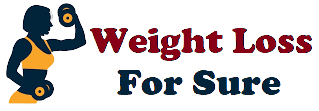Fact Checked
Evidence Based
Most people don’t give much thought to their calf workouts, doing just a few perfunctory sets of calf exercises at the end of their leg workout each week.
Training like this will never build standout calves, though.
To see real results, you have to understand how to train your calves to build mass, which exercises to do, and how to put everything together into effective workouts.
In this article, you’ll learn exactly how to do all of this.
Training Tips for Building Calf Mass
The calves comprise two muscles: The gastrocnemius and the soleus. Both muscles help you point your toes (plantar flexion)
Here’s how they look:
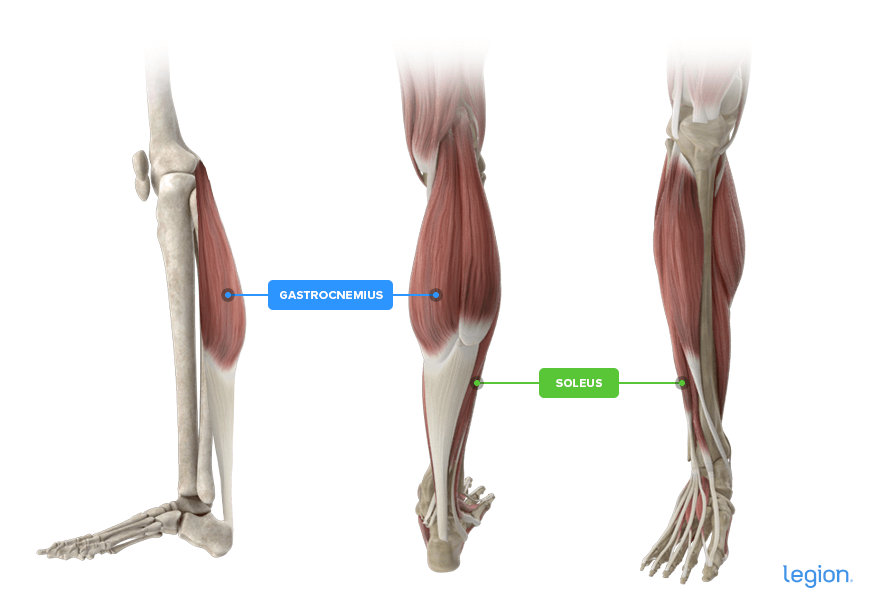
An important difference between these muscles is how bending your knees affects them. Bending your knees reduces tension in the gastrocnemius and increases it in the soleus. The opposite occurs when you straighten your knees.
As such, certain calf exercises train these muscles differently. For instance, exercises performed with bent legs don’t effectively train the gastrocnemius because it can’t fully contract in this position. Likewise, when you do calf exercises with straight knees, the gastrocnemius is more involved than the soleus.
So, if you want to maximize your calf muscles’ size and strength, you need to do calf exercises with your knees bent and straight.
The Best Calf Workout for Mass
Here’s a short and sweet calf workout for mass you can put into practice right away:
- Choose two calf exercises from the list below (ideally, one with bent knees and one with straight knees).
- Do them for the prescribed number of sets and reps at the end of two of your workouts each week (most people like to tack them onto the end of lower body or pulling workouts).
- Do these calf workouts for 8-to-12 weeks before choosing two new exercises and repeating the process.
For example, let’s say you choose the leg press calf raise and the seated calf raise machine as your first two calf exercises.
At the end of your Tuesday pull workout, you’d do 3 sets of 6-to-8 reps on the leg press calf raise, then 3 sets of 10-to-12 reps on the seated calf raise machine.
At the end of your legs workout on Thursday, you’d repeat the same calf workout you did on Tuesday: 3 sets of 6-to-8 reps on the leg press calf raise, then 3 sets of 10-to-12 reps on the seated calf raise machine.
Use double progression to add reps and then weight in every workout for 8-to-12 weeks, then take a deload week, swap your previous calf exercises for two different exercises from the list below, and repeat the process for another 8-to-12 weeks.
The Best Calf Exercises for Mass
1. Seated Calf Raise Machine
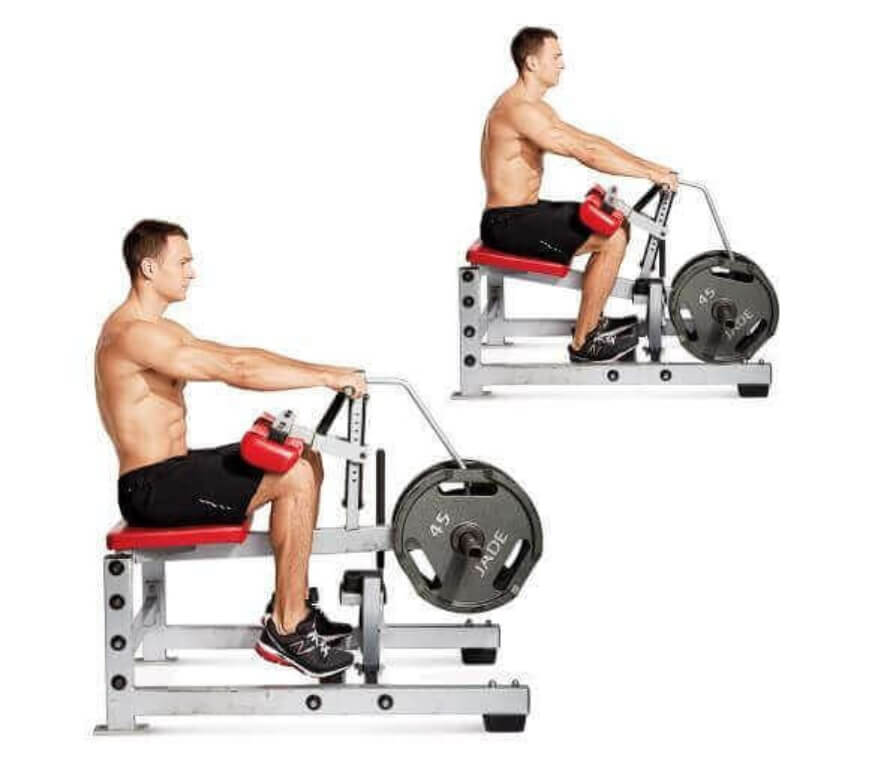
- While seated, adjust the thigh pad so that it rests just above your knee and place the balls of your feet on the footplate.
- Lift the pad slightly by pointing your toes, and use the safety handle to release the weight.
- While keeping your feet on the footplate, lower the weight as far as possible by lowering your heels toward the floor.
- Push through the balls of your feet to elevate the thigh pad as high as you can, and then lower your heels to return to the starting position.
Reps: 10-to-12
Sets: 3
Rest: 2-to-3 min
2. Leg Press Calf Raise
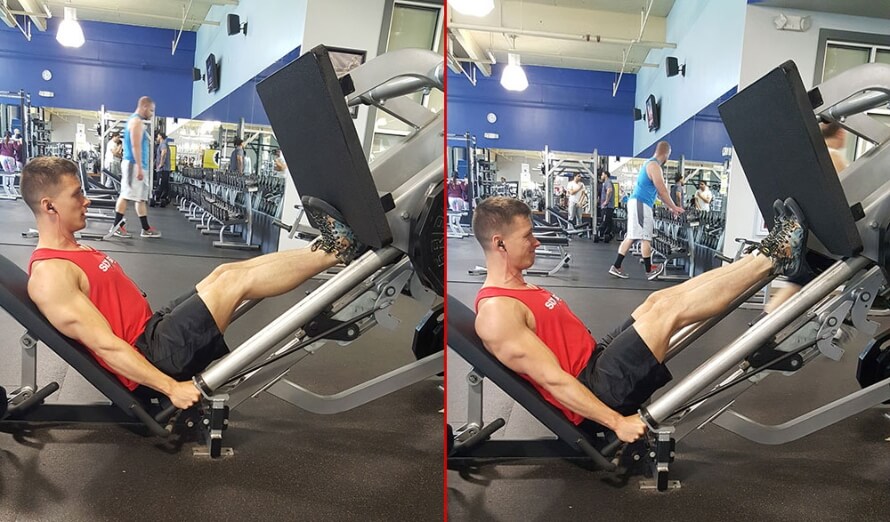
The leg press calf raise is easy to set up and load with heavy weights, which makes it ideal for building mass and strength in your calves.
- Sit in the leg press machine seat and wedge your butt down into the base of the seat.
- Place your feet shoulder-width apart and toward the bottom of the footplate so that the balls of your feet are touching the footplate, but the rest of your foot hangs off the bottom.
- Using your legs, press the footplate away from your body and use the safety handles to release the weight.
- While keeping a slight bend in your knees, lower the footplate toward your chest by allowing the weight to push your toes toward your shins.
- When you feel a deep stretch in your calf muscles, push the footplate away from you by forcefully pointing your toes.
Reps: 6-to-8
Sets: 3
Rest: 2-to-3 min
3. Standing Barbell Calf Raise
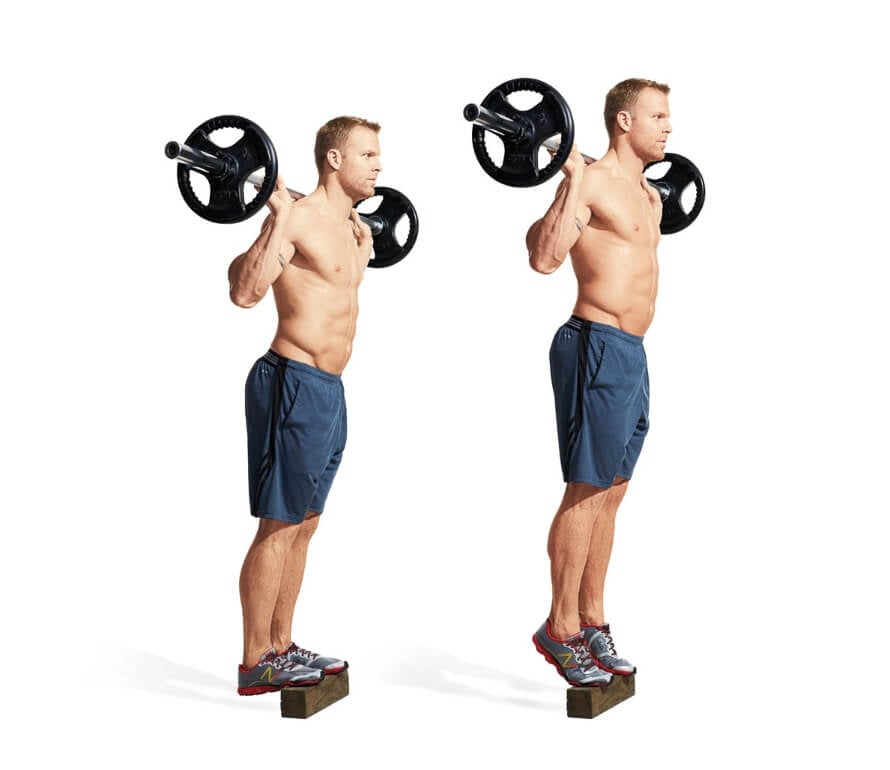
The standing barbell calf raise is a good calf exercise for when you have limited equipment. However, it requires a lot of balance and coordination, so it’s best to use lighter weights and higher reps.
- Position a barbell in a squat rack at about the height of your nipples and place a calf raise block, step, or weight plate on the floor two-to-three feet in front of the squat rack.
- Step under the bar, pinch your shoulder blades together, and rest the bar directly across your upper traps.
- Lift the bar out of the rack, take one or two steps backward taking care not to trip on the calf raise block, and place the balls of your feet on the block.
- Raise your heels as high as possible by pushing through the balls of your feet.
- Lower the weight as far as possible by lowering your heels toward the floor.
Reps: 15-to-20
Sets: 3
Rest: 2-to-3 min
4. Standing Calf Raise Machine
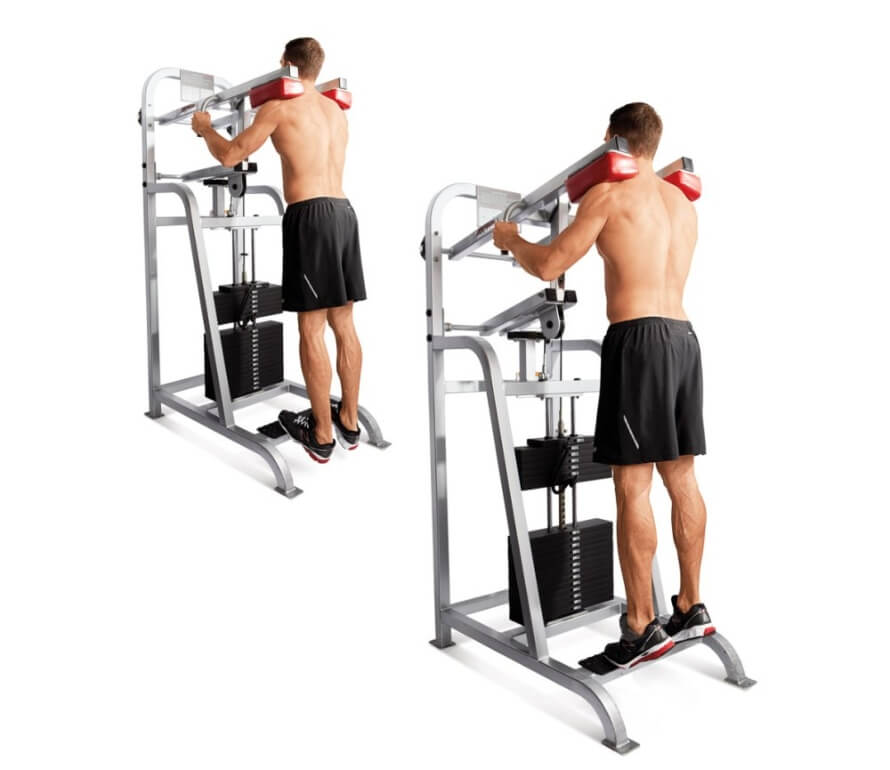
The standing calf raise machine adds overall mass to your calves. Because you perform it with straight legs, though, it emphasizes your gastrocnemius, which means it’s particularly good for developing the shape and appearance of your calves.
- Place the balls of your feet on the footplate and crouch slightly so that the shoulder pads rest on your shoulders.
- Stand up straight so that your body is supporting the weight.
- While keeping the balls of your feet on the footplate, lower the weight as far as possible by lowering your heels toward the floor.
- Push through the balls of your feet to elevate the shoulder pads as high as you can, and then lower your heels to return to the starting position.
Reps: 10-to-12
Sets: 3
Rest: 2-to-3 min
5. Standing Dumbbell Single-Leg Calf Raise
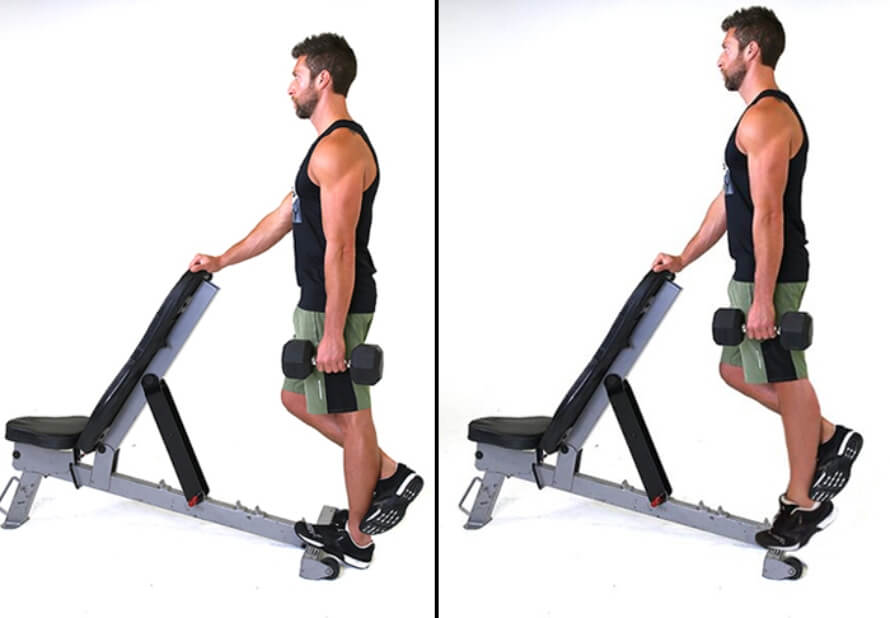
Because the standing dumbbell single-leg calf raise trains just one leg at a time, it’s useful for finding and fixing muscle or strength imbalances. However, because it requires more balance and coordination than other calf exercises, it’s best to use lighter weights and work in a higher rep range.
- Position a calf raise block, step, or weight plate near a squat rack, or adjust a bench to between 45 and 60 degrees and stand behind it, then grab a dumbbell in your left hand.
- Hold the squat rack or the top of the bench (where your head normally goes) with your right hand for support, and place the ball of your left foot on the calf raise block or the base of the bench.
- Bend your right knee and lift your right foot off the floor.
- Raise your left heel as high as possible by pushing through the ball of your left foot.
- Lower the weight as far as possible by lowering your left heel toward the floor.
- Once you’ve completed the desired number of reps, switch sides and repeat the process with your right leg.
Reps: 12-to-15
Sets: 3
Rest: 2-to-3 min
6. Seated Dumbbell Calf Raise
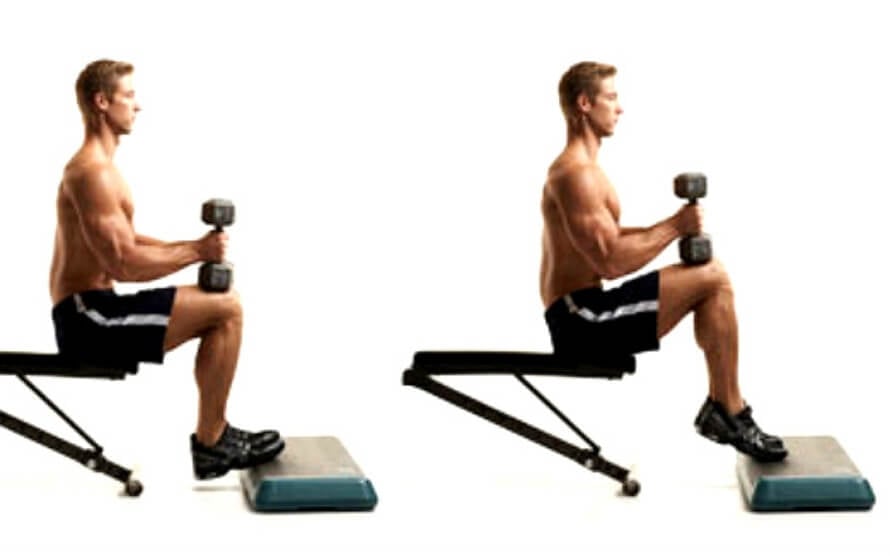
The seated dumbbell calf raise is a solid calf exercise for mass because it emphasizes your soleus. It also requires minimal equipment, so it’s a great option if you train in a home gym.
- Position a calf raise block, step, or weight plate about 12-to-18 inches away from a bench.
- While holding a dumbbell in each hand, sit on the bench, place the dumbbells on your thighs, and position the balls of your feet on the edge of the calf raise block.
- Lower the weights as far as possible by lowering your heels toward the floor.
- Raise your heels as high as possible by pushing through the balls of your feet, and then lower your heels to return to the starting position.
Reps: 15-to-20
Sets: 3
Rest: 2-to-3 min
7. Donkey Calf Raise
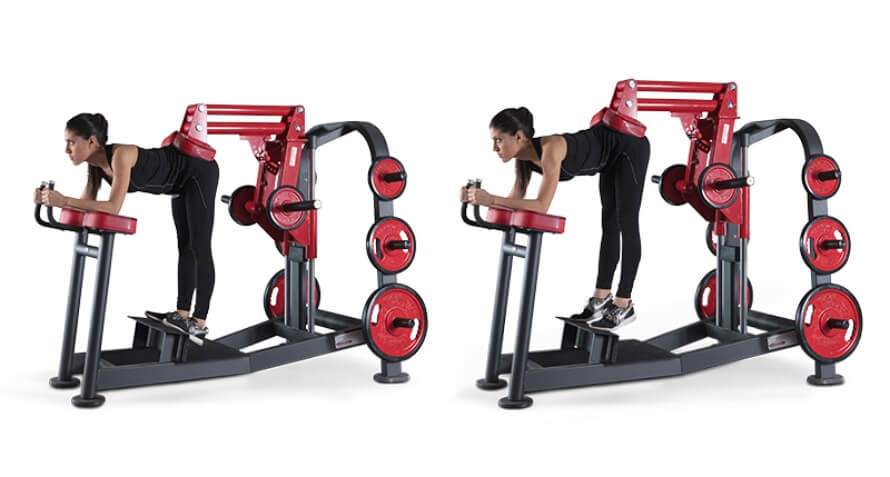
The donkey calf raise trains your calves while stretched, making it highly effective for building calf muscle.
- Position yourself in the donkey calf raise machine with your elbows on the elbow pad, the balls of your feet in the footplate, and the back pad on your lower back.
- Lower the weights as far as possible by lowering your heels toward the floor.
- Raise your heels as high as possible by pushing through the balls of your feet, and then lower your heels to return to the starting position.
Reps: 10-to-12
Sets: 3
Rest: 2-to-3 min
8. Bodyweight Single-Leg Calf Raise
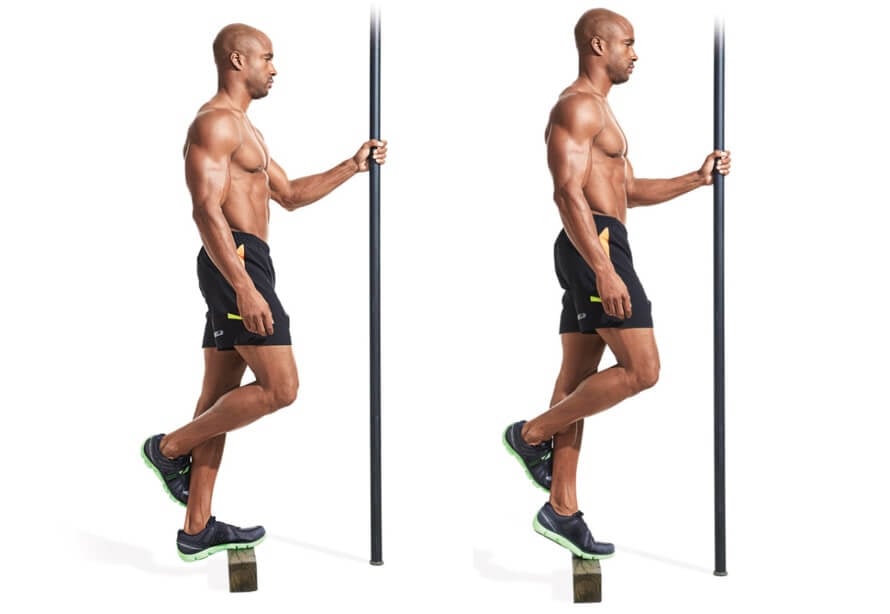
Bodyweight single-leg calf raises are a good calf builder if you’re new weightlifters or don’t have access to gym equipment. Because there’s no external weight involved, it’s best to use a high rep range and short rest periods and try to take each set close to muscular failure
- Place a calf raise block, step, or weight plate near something sturdy that you can use as a support (a squat rack or an adjustable bench set at 70-to-90 degrees work well).
- Place the ball of your left foot on the calf raise block and take hold of the support with your left hand.
- Raise your right foot off the floor by bending your knee.
- Raise your left heel as high as possible by pushing through the ball of your left foot.
- Lower your body as far as possible by lowering your left heel toward the floor.
- Once you’ve completed the desired number of reps, switch sides and repeat the process with your right leg.
Reps: 10-to-30
Sets: 3
Rest: 1-to-2 min
9. Smith Machine Calf Raise
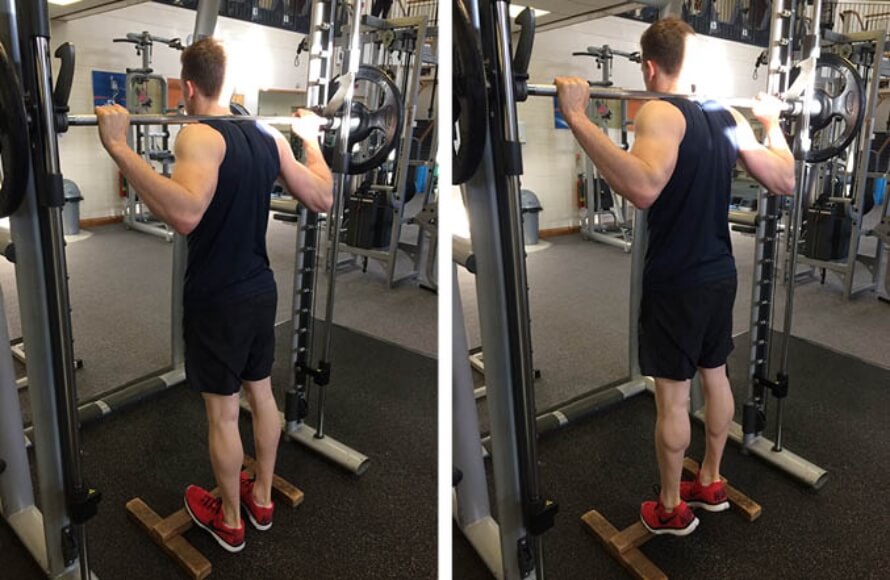
The Smith machine calf raise trains your calves in a similar way to the standing barbell calf raise. Since the bar on the Smith machine can only move up and down, though, it doesn’t require as much balance, which allows you to lift more weight and progress faster, which benefits muscle growth.
- Set the bar on a Smith machine at about the height of your nipples and place a calf raise block, step, or weight plate on the floor directly under the bar.
- Step under the bar, pinch your shoulder blades together, and rest the bar directly across your upper traps.
- Twist the bar to take it off the safety hooks, then stand up straight to lift the bar upward.
- Place the balls of your feet on the calf raise block and lower the weight as far as possible by lowering your heels toward the floor.
- Raise your heels as high as possible by pushing through the balls of your feet, and then lower your heels to return to the starting position.
Reps: 10-to-12
Sets: 3
Rest: 2-to-3 min
10. Farmer’s Walk
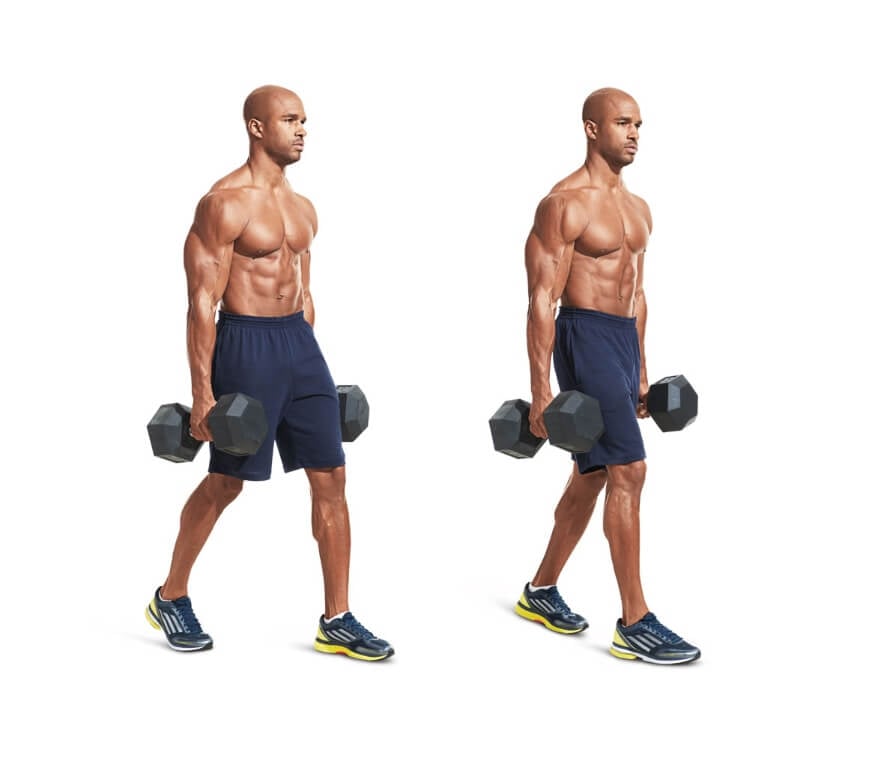
While it might not look like much, the farmer’s walk is one of the best calf exercises for mass because your calves have to work very hard to propel your body forward.
- Stand up straight and hold a dumbbell in each hand.
- Keeping your shoulder blades pulled together and down, take small, quick, even steps forward.
- If you run out of space to continue walking forward, turn around and walk back to the starting point without dropping the dumbbells.
- Walk for a set distance, a certain number of steps, or until you feel like you have to drop the dumbbells.
Reps: As many steps as possible
Sets: 3
Rest: 2-to-3 min
FAQ #1: What is the best exercise for your calves?
There’s no single “best” exercise for your calves. To fully develop your calves, doing a combination of bent- and straight-leg calf exercises works best.
FAQ #2: Are calves hard to grow?
Some people get the best results from high-rep training. For others, low-rep training yields better results. And in some cases, the number of reps doesn’t seem to matter.
Therefore, if your calves aren’t growing, it’s likely not because you have “poor” genetics but because you aren’t doing the “right” type of training. Experimenting with rep ranges can help with this.
For example, if you’re not seeing results from low-rep, heavy-weight workouts, switch to high-rep, lighter-weight workouts. If you usually do high-rep workouts, try low-rep sessions with heavier weights to see if that helps.
FAQ #3: Do squats grow calves?
If you’re new to weightlifting, compound exercises, such as squats, lunges, and deadlifts, are likely enough to cause calf growth. As you become more experienced, however, you need to do more direct calf training if you want to add calf mass. And that means incorporating some of the calf exercises from above into your routine.
FAQ #4: Are calf workouts for men and women the same?
Yes, there’s nothing physiologically different about men and women’s calves, so both can benefit from the same style of calf training.
FAQ #5: Can you train calves every day?
You can if you want.
I recommend doing just 3 sets per workout, and if your feet, knees, or Achilles tendons begin to complain, dial back your training a little.
+ Scientific References
- Lauber, Benedikt, et al. “Reciprocal Activation of Gastrocnemius and Soleus Motor Units Is Associated with Fascicle Length Change during Knee Flexion.” Physiological Reports, vol. 2, no. 6, June 2014, p. e12044, https://doi.org/10.14814/phy2.12044. Accessed 13 Jan. 2020.
- Arampatzis, Adamantios, et al. “Effect of Different Ankle- and Knee-Joint Positions on Gastrocnemius Medialis Fascicle Length and EMG Activity during Isometric Plantar Flexion.” Journal of Biomechanics, vol. 39, no. 10, Jan. 2006, pp. 1891–1902, https://doi.org/10.1016/j.jbiomech.2005.05.010. Accessed 23 Apr. 2020.
- Miyamoto, Naokazu, and Shingo Oda. “Mechanomyographic and Electromyographic Responses of the Triceps Surae during Maximal Voluntary Contractions.” Journal of Electromyography and Kinesiology, vol. 13, no. 5, Oct. 2003, pp. 451–459, https://doi.org/10.1016/s1050-6411(03)00058-0.
- Fukunaga, T., et al. “Physiological Cross-Sectional Area of Human Leg Muscles Based on Magnetic Resonance Imaging.” Journal of Orthopaedic Research, vol. 10, no. 6, Nov. 1992, pp. 926–934, https://doi.org/10.1002/jor.1100100623.
- Oranchuk, Dustin J., et al. “Isometric Training and Long-Term Adaptations: Effects of Muscle Length, Intensity, and Intent: A Systematic Review.” Scandinavian Journal of Medicine & Science in Sports, vol. 29, no. 4, 13 Jan. 2019, pp. 484–503, https://doi.org/10.1111/sms.13375.
- Farris, Dominic James, and Gregory S. Sawicki. “Human Medial Gastrocnemius Force–Velocity Behavior Shifts with Locomotion Speed and Gait.” Proceedings of the National Academy of Sciences, vol. 109, no. 3, 17 Jan. 2012, pp. 977–982, www.pnas.org/content/109/3/977, https://doi.org/10.1073/pnas.1107972109.
- Schoenfeld, Brad J., et al. “Do the Anatomical and Physiological Properties of a Muscle Determine Its Adaptive Response to Different Loading Protocols?” Physiological Reports, vol. 8, no. 9, 27 Apr. 2020, https://doi.org/10.14814/phy2.14427.
You May Also Like
Our Most Popular Evidence-Based Articles
You don’t need supplements to build muscle, lose fat, and get healthy. But the right ones can help.
Take our 60-second quiz now to learn which supplements can help you achieve your fitness goals faster.
Sending…
Your free stuff is on the way!
Follow the Diet Plan that Helped Nikita Lose 15 Pounds in 3 Months
“I never thought getting in shape would be this simple! Everything just WORKS when you follow this plan.” And if he can do it, why not you?

Wait!
Want a Free Custom Meal Planning Tool?
Quickly calculate your calories, macros, and micros for losing fat, building muscle, and staying healthy.
Our “No Return Necessary”
Money-Back Guarantee
If you don’t like something of ours, guess what happens next?
No, we don’t request you deliver it to a PO box in the Gobi Desert by carrier pigeon. Nor do we ask you to fill a cursed inkwell with orc’s blood and demon saliva and then use it to complete reams of return forms written in ancient Cyrillic script.
We just . . . wait for it . . . give you your money back. Holy moo cows. And that means you can say “yes” now and decide later.
Free Worldwide Shipping & Returns
Many companies use shipping and handling fees to increase their profit margins, but here at Legion, we hate profits, so our shipping is free!
Okay, so we do dig on profits, but we also go in for happy customers, and free shipping works like gangbusters. So, if you live in the United States, your order ships free regardless of order size, if you live in the UK, Canada, Puerto Rico, or Guam, your order ships free when it’s over $99, and if you live elsewhere, your order ships free when it’s over $199.
Also, if you don’t absolutely love our stuff for whatever reason, we don’t request you deliver it to a PO box in the Gobi Desert by carrier pigeon.
We just . . . wait for it . . . give you your money back. No returns. No forms. No nonsense. Holy moo cows.
That means you can say “yes” now and decide later. You really have nothing to lose.
Free Worldwide Shipping & Returns
Many companies use shipping and handling fees to increase their profit margins, but here at Legion, we hate profits, so our shipping is free!
Okay, so we do dig on profits, but we also go in for happy customers, and free shipping works like gangbusters. So, if you live in the UK, Canada, Puerto Rico, or Guam, your order ships free when it’s over $99.
Why the restriction on international orders? Unfortunately, shipping abroad is very expensive, and if we didn’t require a minimum order size, we’d lose a lot of money. But! We’re also hustling to improve our international logistics and will be passing our savings along to our international customers.
Also, if you don’t absolutely love our stuff for whatever reason, we don’t request you deliver it to a PO box in the Gobi Desert by carrier pigeon.
We just . . . wait for it . . . give you your money back. No returns. No forms. No nonsense. Holy moo cows.
That means you can say “yes” now and decide later. You really have nothing to lose.
Free Worldwide Shipping & Returns
Many companies use shipping and handling fees to increase their profit margins, but here at Legion, we hate profits, so our shipping is free!
Okay, so we do dig on profits, but we also go in for happy customers, and free shipping works like gangbusters. So, if you’re outside the USA, your order ships free when it’s over $199.
Why the restriction on international orders? Unfortunately, shipping abroad is very expensive, and if we didn’t require a minimum order size, we’d lose a lot of money. But! We’re also hustling to improve our international logistics and will be passing our savings along to our international customers.
Also, if you don’t absolutely love our stuff for whatever reason, we don’t request you deliver it to a PO box in the Gobi Desert by carrier pigeon.
We just . . . wait for it . . . give you your money back. No returns. No forms. No nonsense. Holy moo cows.
That means you can say “yes” now and decide later. You really have nothing to lose.
Clinically Effective Ingredients & Doses
Many ingredients in supplements don’t have any scientifically validated benefits, and many ingredients that do are often underdosed to the point of irrelevance.
That’s why we only use the choice ingredients and precise doses shown to be effective in peer-reviewed scientific studies.
Clinically Effective Doses
You need more than great ingredients to make great products—you also need proper doses. That’s why we use the precise doses of ingredients shown to be effective in peer-reviewed scientific studies.
Natural Ingredients
“Natural” doesn’t always mean “better,” but in many cases, natural ingredients are superior to artificial ones for various reasons, including purity, safety, and efficacy.
That’s why all of our ingredients in all of our products come from plant and animal sources, including sweeteners, colors, and flavors.
Made in USA with Globally Sourced Ingredients
If you want to ensure the supplements you’re swallowing every day are safe and effective, you want products produced in the USA.
That’s why all of our supplements are made in America in NSF-certified and FDA-inspected facilities that operate in accordance with the Current Good Manufacturing Practice (cGMP) regulations.
Lab Tested
Did you know that supplements can contain dangerously high levels of toxins like lead, arsenic, and cadmium?
That’s why we test every ingredient of every supplement we produce for heavy metals, microbes, allergens, and other contaminants and ensure they meet the strict purity standards set by the FDA.
Naturally Sweetened & Flavored
While artificial sweeteners may not be as dangerous as some people claim, studies suggest that regular consumption of these chemicals may indeed be harmful to our health.
That’s why all of our supplements are naturally sweetened and flavored and contain no artificial food dyes, fillers, or other unnecessary junk.
Science-Backed Ingredients
Many ingredients in supplements don’t have any scientifically validated benefits. That’s why we only use choice ingredients shown to be effective in peer-reviewed scientific studies.
No Chemical Junk
“Natural” doesn’t always mean “better,” but in many cases, natural ingredients are superior to artificial ones for various reasons, including purity, safety, and efficacy.
That’s why all of our ingredients in all of our products come from plant and animal sources, including sweeteners, colors, and flavors.


Split your entire online purchase into 4 interest-free payments, over 6 weeks with no impact to your credit.

25%
today
25%
2 weeks
25%
4 weeks
25%
6 weeks

Shop and add items to your cart as normal!

Choose Sezzle at Checkout! You’ll be redirected to Sezzle to Sign Up or Log In
to complete your order.

Your order will be shipped out right away* and your payments will be split up
over 6 weeks.
*shipping times subject to merchant shipping policy
Shop directory. Reschedule payments. Plus more!
Waiver and Release of Liability
In consideration of the services and/or products offered by Legion Athletics, Inc. (“Legion”) including, but not limited to, nutrition plans, exercise routines and coaching, and in addition to the payment of any fee or charge:
I knowingly and voluntarily enter into this waiver and release of liability and hereby waive any and all rights, claims or causes of action of any kind whatsoever arising out of my use of Legion’s services and/or products, and I hereby release and hold harmless Legion and its consultants, officers, contractors, agents, owners and employees from any and all responsibility, liability, cost and expenses, including for injuries, damages or disorders (physical, metabolic, or otherwise), resulting from my use of Legion’s services and/or products.
I understand that fitness activities including, but not limited to, strength, flexibility, and cardiovascular exercise, with or without the use of equipment, are potentially hazardous activities that involve a risk of injury and even death, and I am voluntarily participating in these activities and using equipment and machinery with knowledge of the risks involved. I hereby agree to assume and accept any and all risks of injury or death related to said fitness activities.
I understand Legion’s services and products are not meant to treat or manage any health conditions or circumstances, and I acknowledge that Legion has recommended I obtain a healthcare provider’s approval for my use of Legion’s services and/or products, through regular physical examination(s) and/or consultation. I acknowledge that I have obtained my healthcare provider’s approval or have decided to use Legion’s services and/or products without such approval and hereby assume all responsibility for my use of said services and/or products.
I understand that results from using Legion’s products and/or services are not guaranteed, and I agree to not hold Legion liable for any outcomes or lack thereof.
OUT OF STOCK
Security Check
Please click the checkbox below. We apologize for the inconvenience.
If you don’t absolutely love this product, just let us know, and we’ll give you a full refund on the spot. No forms or return necessary.
Analyzed for purity and potency in a state-of-the-art ISO 17025 accredited lab by Labdoor™, the gold standard of third-party lab testing.
Analyzed for purity and potency in a state-of-the-art ISO 17025 accredited lab, the gold standard of third-party lab testing.
This product doesn’t just “contain natural ingredients”—every ingredient is naturally sourced from plants and animals. This product contains no artificial or synthetic sweeteners or flavors of any kind.
Fact Checked
Our scientific review board of nutritionists, dietitians, molecular biologists, doctors, and other accredited experts is responsible for reviewing every article, podcast, and video we produce to ensure they’re evidence based, accurate, trustworthy, and current.
Thanks to their connections, credentials, and academic experience, this team of MDs, PhDs, and other professionals has access to a wealth of research published in the largest and most prestigious journals in the world.
This allows them to not only review individual studies but also analyze the overall weight of the evidence on any and all topics related to diet, exercise, supplementation, and more.
If you feel that any of our content is inaccurate, misleading, out-of-date, or anything less than factual, please let us know in the comments section of the article in question.
Evidence Based
We follow a detailed, rigorous, multi-step process to create content that meets the highest standards of clarity, practicality, and scientific integrity.
First, our research associates provide our editorial team with accurate, up-to-date, proven scientific evidence.
Then, our editorial team uses this research to draft articles and outlines for podcasts and videos.
Finally, our scientific review board reviews the content to ensure all key information and claims are backed by high-quality scientific research and explained simply and precisely.
If you feel that any of our content is inaccurate, misleading, out-of-date, or anything less than factual, please let us know in the comments section of the article in question.

